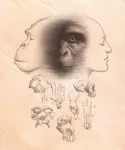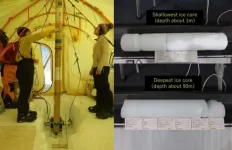(Press-News.org) In the 150 years since Charles Darwin speculated that humans originated in Africa, the number of species in the human family tree has exploded, but so has the level of dispute concerning early human evolution. Fossil apes are often at the center of the debate, with some scientists dismissing their importance to the origins of the human lineage (the "hominins"), and others conferring them starring evolutionary roles. A new review out on May 7 in the journal Science looks at the major discoveries in hominin origins since Darwin's works and argues that fossil apes can inform us about essential aspects of ape and human evolution, including the nature of our last common ancestor.
Humans diverged from apes--specifically, the chimpanzee lineage--at some point between about 9.3 million and 6.5 million years ago, towards the end of the Miocene epoch. To understand hominin origins, paleoanthropologists aim to reconstruct the physical characteristics, behavior, and environment of the last common ancestor of humans and chimps.
"When you look at the narrative for hominin origins, it's just a big mess--there's no consensus whatsoever," said Sergio Almécija, a senior research scientist in the American Museum of Natural History's Division of Anthropology and the lead author of the review. "People are working under completely different paradigms, and that's something that I don't see happening in other fields of science."
There are two major approaches to resolving the human origins problem: "Top-down," which relies on analysis of living apes, especially chimpanzees; and "bottom-up," which puts importance on the larger tree of mostly extinct apes. For example, some scientists assume that hominins originated from a chimp-like knuckle-walking ancestor. Others argue that the human lineage originated from an ancestor more closely resembling, in some features, some of the strange Miocene apes.
In reviewing the studies surrounding these diverging approaches, Almécija and colleagues with expertise ranging from paleontology to functional morphology and phylogenetics discuss the limitations of relying exclusively on one of these opposing approaches to the hominin origins problem. "Top-down" studies sometimes ignore the reality that living apes (humans, chimpanzees, gorillas, orangutans, and hylobatids) are just the survivors of a much larger, and now mostly extinct, group. On the other hand, studies based on the "bottom-up"approach are prone to giving individual fossil apes an important evolutionary role that fits a preexisting narrative.
"In The Descent of Man in 1871, Darwin speculated that humans originated in Africa from an ancestor different from any living species. However, he remained cautious given the scarcity of fossils at the time," Almécija said. "One hundred fifty years later, possible hominins--approaching the time of the human-chimpanzee divergence--have been found in eastern and central Africa, and some claim even in Europe. In addition, more than 50 fossil ape genera are now documented across Africa and Eurasia. However, many of these fossils show mosaic combinations of features that do not match expectations for ancient representatives of the modern ape and human lineages. As a consequence, there is no scientific consensus on the evolutionary role played by these fossil apes."
Overall, the researchers found that most stories of human origins are not compatible with the fossils that we have today.
"Living ape species are specialized species, relicts of a much larger group of now extinct apes. When we consider all evidence--that is, both living and fossil apes and hominins--it is clear that a human evolutionary story based on the few ape species currently alive is missing much of the bigger picture," said study co-author Ashley Hammond, an assistant curator in the Museum's Division of Anthropology.
Kelsey Pugh, a Museum postdoctoral fellow and study co-author adds, "The unique and sometimes unexpected features and combinations of features observed among fossil apes, which often differ from those of living apes, are necessary to untangle which features hominins inherited from our ape ancestors and which are unique to our lineage."
Living apes alone, the authors conclude, offer insufficient evidence. "Current disparate theories regarding ape and human evolution would be much more informed if, together with early hominins and living apes, Miocene apes were also included in the equation," says Almécija. "In other words, fossil apes are essential to reconstruct the 'starting point' from which humans and chimpanzees evolved."
INFORMATION:
This study was part of a collaborative effort with colleagues from the New York Institute of Technology (Nathan Thompson) and the Catalan Institute of Paleontology Miquel Crusafont (David Alba and Salvador Moyà-Solà).
Study DOI: https://science.sciencemag.org/cgi/doi/10.1126/science.abb4363
ABOUT THE AMERICAN MUSEUM OF NATURAL HISTORY (AMNH)
The American Museum of Natural History, founded in 1869 and currently celebrating its 150th anniversary, is one of the world's preeminent scientific, educational, and cultural institutions. The Museum encompasses more than 40 permanent exhibition halls, including those in the Rose Center for Earth and Space, as well as galleries for temporary exhibitions. The Museum's approximately 175 scientists draw on a world-class research collection of more than 34 million artifacts and specimens, some of which are billions of years old, and on one of the largest natural history libraries in the world. Through its Richard Gilder Graduate School, the Museum grants the Ph.D. degree in Comparative Biology and the Master of Arts in Teaching (MAT) degree, the only such free-standing, degree-granting programs at any museum in the United States. The Museum's website, digital videos, and apps for mobile devices bring its collections, exhibitions, and educational programs to millions around the world. Visit amnh.org for more information.
PROVIDENCE, R.I. [Brown University] -- A research team from Brown University has made a major step toward improving the long-term reliability of perovskite solar cells, an emerging clean energy technology. In a study to be published on Friday, May 7 in the journal Science, the team demonstrates a "molecular glue" that keeps a key interface inside cells from degrading. The treatment dramatically increases cells' stability and reliability over time, while also improving the efficiency with which they convert sunlight into electricity.
"There have been great strides ...
MUSC Hollings Cancer Center researchers added to the understanding of the protective immune response against the SARS-CoV-2 virus in a study published in April in iScience. The team found that approximately 3% of the population is asymptomatic, which means that their bodies can get rid of the virus without developing signs of illness.
The researchers screened more than 60,000 blood samples from symptomless individuals in the Southeastern U.S., including Georgia, South Carolina and North Carolina, for the IgG antibody to the viral spike protein.
What began as a highly collaborative statewide effort to detect SARS-CoV-2 accurately, ...
Recently published research from the University of Arizona Health Sciences shows that advanced-stage kidney cancer is more common in Hispanic Americans and Native Americans than in non-Hispanic whites, and that both Hispanic Americans and Native Americans in Arizona have an increased risk of mortality from the disease.
"We knew from our past research that Hispanic Americans and Native Americans have a heavier burden of kidney cancer than non-Hispanic whites," said Ken Batai, PhD, a Cancer Prevention and Control Program research member at the UArizona Cancer Center and research assistant professor of urology in the College of Medicine - Tucson. "But we also know that around 90% of the Hispanic population in Arizona is Mexican American - either U.S.-born or Mexican-born ...
The air in the United States and Western Europe is much cleaner than even a decade ago. Low-sulfur gasoline standards and regulations on power plants have successfully cut sulfate concentrations in the air, reducing the fine particulate matter that harms human health and cleaning up the environmental hazard of acid rain.
Despite these successes, sulfate levels in the atmosphere have declined more slowly than sulfur dioxide emissions, especially in wintertime. This unexpected phenomenon suggests sulfur dioxide emission reductions are less efficient than expected for cutting sulfate aerosols. A new study led by Tokyo Institute of Technology (Tokyo Tech), Hokkaido University and the University ...
The ability of antibodies to recognize specific cancer cells is used in oncology to specifically target those cells with small active agents. Research published in the journal Angewandte Chemie shows that scientists have now built a transport system that delivers even large protein-based drugs into cancer cells. This study demonstrates how proteins can arrive at their target intact, protected from destructive proteases by polymer brushes.
Developing anticancer treatments involves two recurring problems for researchers. An active agent needs to be able to kill the body's cells at the root of the cancer, and it should be active in target cancer cells rather than in healthy cells. Many medical researchers ...
When you save an image to your smartphone, those data are written onto tiny transistors that are electrically switched on or off in a pattern of "bits" to represent and encode that image. Most transistors today are made from silicon, an element that scientists have managed to switch at ever-smaller scales, enabling billions of bits, and therefore large libraries of images and other files, to be packed onto a single memory chip.
But growing demand for data, and the means to store them, is driving scientists to search beyond silicon for materials that can push memory devices to higher densities, ...
For millennia, humans in the high latitudes have been enthralled by auroras--the northern and southern lights. Yet even after all that time, it appears the ethereal, dancing ribbons of light above Earth still hold some secrets.
In a new study, physicists led by the University of Iowa report a new feature to Earth's atmospheric light show. Examining video taken nearly two decades ago, the researchers describe multiple instances where a section of the diffuse aurora--the faint, background-like glow accompanying the more vivid light commonly associated with auroras--goes dark, as if scrubbed by a giant blotter. Then, after a short period of time, the blacked-out section suddenly reappears.
The researchers say the behavior, which they call "diffuse ...
New research published in Experimental Physiology highlight the possible long term health impacts of COVID-19 on young, relatively healthy adults who were not hospitalized and who only had minor symptoms due to the virus.
Increased stiffness of arteries in particular was found in young adults, which may impact heart health, and can also be important for other populations who may have had severe cases of the virus. This means that young, healthy adults with mild COVID-19 symptoms may increase their risk of cardiovascular complications which may continue for some time after COVID-19 infection.
While SARS-CoV-2, the virus known ...
Just as people keep their houses clean and clutter under control, a crew of cells in the body is in charge of clearing the waste the body generates, including dying cells. The housekeeping cells remove unwanted material by a process called phagocytosis, which literally means 'eating cells.' The housekeepers engulf and ingest the dying cells and break them down to effectively eliminate them.
"Phagocytosis is very important for the body's health," said Dr. Zheng Zhou, whose lab at Baylor College of Medicine has been studying phagocytosis for many years and provided key new insights into this essential process. "When this cell-eat-cell process fails, the dying cells will lose their integrity, break down and release their content into the surrounding tissues. Dumping the ...
St. Jude Children's Research Hospital scientists have developed an integrated, high-throughput system to better understand and possibly manipulate gene expression for treatment of disorders such as sickle cell disease and beta thalassemia. The research appears today in the journal Nature Genetics.
Researchers used the system to identify dozens of DNA regulatory elements that act together to orchestrate the switch from fetal to adult hemoglobin expression. The method can also be used to study other diseases that involve gene regulation.
Regulatory elements, also called genetic switches, are scattered throughout non-coding regions of DNA. ...




